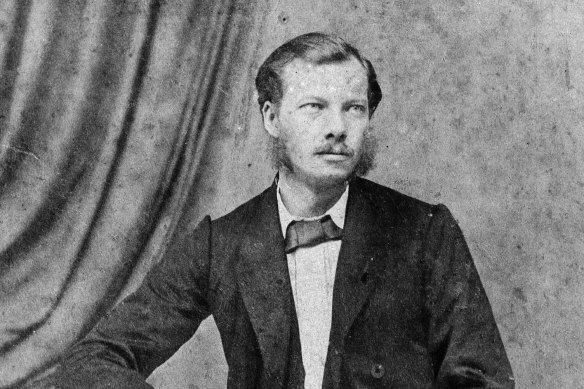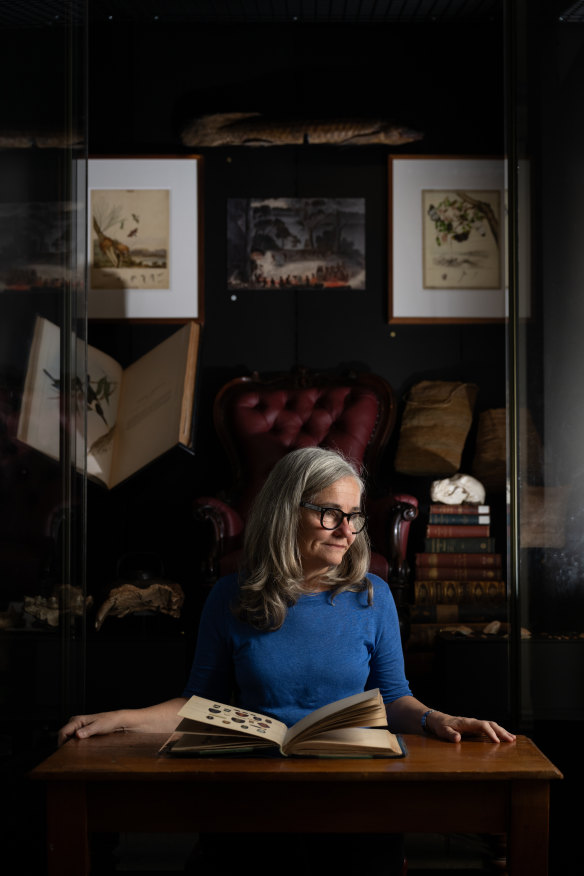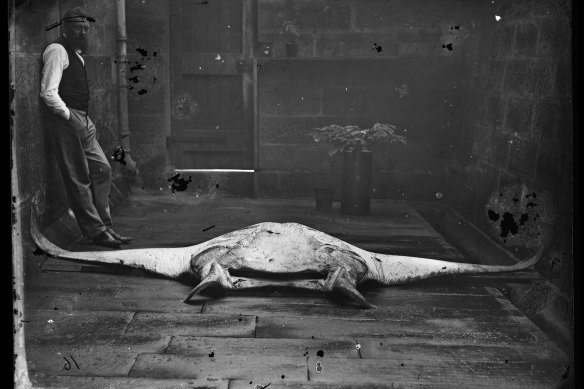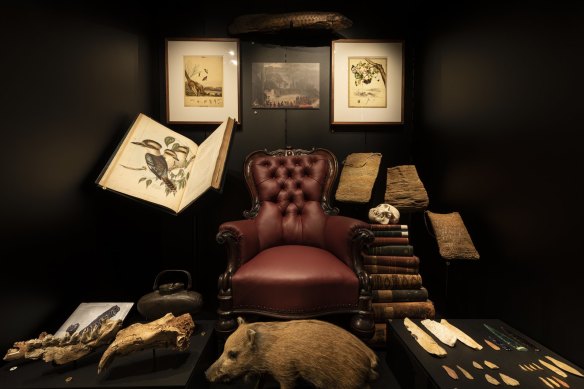It happened 150 years ago, today – the climax of an extraordinary clash of culture and colonialism, science and Sydney society, bureaucracy and boxers, which had the harbour city agog for months thereafter.
Look, many of us Sydneysiders knew Johann Louis Gerard Krefft was a troublemaker from shortly after the tall, thin, ascetic German man took over as director of the Australian Museum, that grand sandstone building on the corner of William and College streets opposite Hyde Park.
It was not just his suspiciously foreign ways. It was not even that on expeditions around the country he had variously raised the alarm about the effect that colonisation was having on the native population, and on wildlife. That was bad enough – after all, who cares? – as was his generally prickly arrogance and insistence Australian institutions like his should stop automatically sending specimens to great institutions overseas such as the British Museum, and start to conserve, preserve, and present here in Australia – maintaining that Australia should develop the capacity to photograph and study its own treasures.

Darwinist and former Australian Museum director Gerard Krefft.
The very worst of it was his blasphemy. Most of us recognised Charles Darwin for what we were sure he was, a crackpot who’d visited in 1838 and used what he had found to help propound his theories of evolution and natural selection in his book, On the Origin of the Species.
One of the museum’s own trustees, W.S Macleay, had written, “It is far easier for me to believe in the direct and constant Government of the Creation of God, than that He should have created the world and then left it to manage itself.”
Exactly.
But Krefft had gone the other way, insisting Darwin was right, and his theory helped explain things like one of his proudest discoveries, the Australian lungfish which – with one lung, as well as a set of gills, and fins with the same bone structure as upper arms – was like a bridge creature between fossils and living animals. Even though Krefft had been on the Eureka, this was truly his Eureka moment.
Krefft would later even say, “. . . I have tried to make people understand what the meaning of the theory of evolution really is . . . I have ceased to believe in Moses and the Prophets.”
Good . . . God!

Australian Museum curator Vanessa Finney with the red chair that Krefft was carried out in.Credit: Louie Douvis
Krefft was so vocal in his support Darwin had written to warmly thank him. Krefft had written back, decrying the fact he was effectively living among savages who did not understand Darwin’s genius, and he could make no headway against “the ignorance of even well educated people”.
The fact he has made no effort to hide his contempt of the rest of us, led us to this point. For nothing will make Krefft shut up, or be less rambunctious in his remarks and general manner, notwithstanding the personal advice of Sir Henry Parkes that in the face of the Creationists, he must “keep a cool temper and a respectful bearing even to gentlemen who may be opposed to you”.
That is beyond him, just as it is beyond the trustees to leave his outrageous arrogance unchecked.
Using such things as allegations of drunkenness and missing gold from the collection – allegations of indeterminate legitimacy – they try to sack him, but he refuses to go!
And so it has come to this.
In the middle of a Saturday morning, one of the most outraged of the trustees, Edward Hill, who has been deputised by the rest to lead the charge, arrives at the door of Krefft’s upstairs private apartment. He is accompanied by the bailiff, Charles H. Peart, a couple of associates and more significantly, two likely lads – one of whom is a professional pugilist – whose services he has secured by waving some cash around at the famous Kiss’s Horse Bazaar on Pitt Street.
If Krefft gives them any resistance, Hill and the bailiff have the muscle they need.

Gerard Krefft with the newly discovered manta ray, Manta alfredi, in the museum’s courtyard in 1869. Credit: Henry Barnes. Australian Museum
After pounding on the door for no result, Hill demands it be opened “In the Queen’s name!”
That name, alas, does not do it, and the door remains securely bolted and barred. So pass the axe. When one of the panels is bashed in, one of the party crawls through “receiving such an impetus from behind by way of assisting his ingress,” the Herald will later report, “that he fell upon his back on the floor.”
But the door is opened, and the raiding party bursts in to find . . .
Krefft’s wife of five years – described by Krefft himself as a Scot, “born of free parents in this Country of rogues and vagabonds” – calmly discussing with studied nonchalance, luncheon arrangements, with her brother and a young lady.
“Where is Mr Krefft??” Hill roars, shaking his stick most particularly at the young lady he later described as “a pert little thing.”
But Annie Krefft rises to the occasion and asks by what authority he dares put this question.
Authority? Authority?
“I am the authority!” he says, before – as the young lady in question, “sick with fright”, pertly goes into a dead faint on the sofa, – he instructs his bovver boys, “Find the giant, wherever he is.”
They do their best, one of them pausing to tell Hill, “For God’s sake, leave her alone.”
Mrs Krefft’s brother, meanwhile, helps himself to the generous cheese platter, but also pauses long enough to tell Hill to desist.
“You have no business here,” Hill tells him, “and I have good a mind to give you a night in ‘chokey’.”
Putting down his cheese, the brother offers to “take any of the party single-handed,” upon which, as the Herald will report, “one of the fighting-men obligingly promised to ‘knock his brains out,’ on the first opportunity.”
But to Krefft!
Finding the door to the drawing room also locked it is perceived he must be in there and once that door is also forced, sure enough, there he is, sitting in his plush red armchair, calmly reading the paper.
“Damn you,” Hill cries, doing God’s work, “get him out. Get the bastard out.”
This time, the authority is read out by the bailiff just to make it all legal-beagle and ridgy-didge: “The Trustees of the Australian Museum authorise Charles H. Peart to remove the late Curator, Mr. Gerard Krefft, and his family, and all furniture and effects belonging to him, from the Museum premises.”
Krefft declares he does not recognise any such authority, whereupon he is told, “If you don’t leave we shall have to put you out.”
Exactly.
“Take him out holus bolus,” Hill orders.
As the two men from the horse bazaar lift him in the chair and head towards the door, Krefft laughs, even as his wife, her brother, and the pert young lady make cries to the order of “Murder! Police!” but it is of no use. In short order, Mr Krefft is on William Street, still laughing.

The chair that Krefft was carried out in when he was forcibly removed from the museum.
But not for long, as he is soon joined by the rest of his party, less his wife who has already departed to the Colonial Secretary’s Office to make complaint. She returns to find him still on the street, and the apartment chained shut.
Friends? The repercussions go for years.
Yes, Krefft will win the subsequent court case and be awarded damages of £250 – a big comedown from the £2000 he had sought for trespass and assault – but he will never regain the position of Curator, nor any affection for the colony.
He at least has the satisfaction of publishing a journal, Krefft’s Nature in Australia. A Popular Journal for the Discussion of Questions of Natural history, where he delights in referring to the museum trustees as “parasitic flies”, as well as opening an alternative museum around the corner in Stanley Street, but he truly never recovers, without even enough money to leave.
He writes to Darwin seeking help, pointing out “Had I been an Englishman by birth, had I humbugged people, attended at Church and spread knowledge on the principle that the God of Moses and of the Prophets made ‘little apples’ I would have gained the day but a true believer in the theory of development I am hounded down in this Paradise of Bushrangers’ of rogues Cheats and Vagabonds.”
Darwin sends his sympathies and £5.
Bewildered, broken, but still believing in the theories of Darwin, Krefft died in Woolloomooloo in 1881 at the age of just 51, leaving his widow and two young sons in near penury.
150 years later, Herr Krefft, we remember you. And sorry about that.
Peter FitzSimons will facilitate a panel discussion open to the public at noon on Saturday at the Australian Museum, with Dr Des Griffin, AM, Dr Vanessa Finney and the 17th Museum Director, Kim McKay, AO.